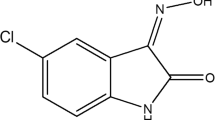Summary
The effect of S-methylfenitrothion on the activity of cholinesterase (ChE) of erythrocytes and plasma was studied as well as the time of its reactivation in rats after peroral administration of 2/3 to 1/100 of LD50. The degradation of S-methylfenitrothion in the organism of rats was evaluated according to the urinary excretion of its metabolite p-nitro-m-cresol. The S-methyl isomer was found to be a more potent inhibitor of cholinesterase than fenitrothion. A remarkable decrease of activity was found even after the administration of 1/100 of LD50. The reactivation of ChE after the administration of 2/3 LD50. took 6 weeks. The excretion was faster and the excreted amounts of p-nitro-m-cresol were significantly higher than they were after fenitrothion administration.
Similar content being viewed by others
References
Doenicke, A.: Klinische Bedeutung der Pseudocholinesterase. In: Pseudocholinesterasen, H.W. Goedde, A. Doenicke, K. Altland, eds., pp.150–157. Berlin-Heidelberg-New York: Springer 1967
Gaines, T.B.: Acute toxicity of pesticides. Toxicol.Appl.Pharmacol.14, 515–534 (1969)
Hladká, A.: Contribution to the Metathione-metabolism in albino-rats. Pracov.Lék.18, 6–10 (1966)
Hladká, A.: Determination of p-nitro-m-cresol in human urine. Z.Anal. Chem.245, 388–390 (1969)
Hladká, A., Nosál, M.: The determination of the exposition to metathion (fenitrothion) on the basis of excreting its metabolite p-nitro-mcresol through urine in rats. Int.Arch.Gewerbepath.Gewerbehyg.23, 209–214 (1967)
Hollingworth, R.M., Metcalf, R.L., Fukuto, T.R.: The selectivity of Sumithion compared with methyl parathion. Metabolism in the white mouse. J.Agr.Food Chem.15, 242–249 (1967)
Kovačicovă, J., Bátora, V., Truchlík, Š.: Hydrolysis rate and in vitro anticholinesterase activity of fenitrothion and S-methyl fenitrothion. Pesticid.Sci.4, 759–763 (1973)
Miyamoto, J., Satô, J., Kadota, T., Fujinami, A.: Studies on the mode of action of organophosphorus compounds. Part II. Agr.Biol.Chem.27, 669–676 (1963)
Pickering, R.G., Martin, J.G.: Modification of the Michel δpH method for the estimation of plasma, erythrocyte and brain cholinesterase activities of various species of laboratory animals. Arch.Toxikol.26, 179–195 (1970)
Rosival, L., Vargovd, M., Hladká, A., Szokolayová, J., Bátora, V., Kovačičová, J.: On the toxicology of S-methyl isomer of fenitrothion (in Slovak). Proc.Toxicological Section Czechoslovak Chem.Assoc., pp.108–112, Liblice, 1973. In: Acta hygienica, epidemiologica et microbiologica, No. 14 (1974)
Author information
Authors and Affiliations
Rights and permissions
About this article
Cite this article
Hladká, A., Krampl, V. Effect of S-methylfenitrothion on the activity of cholinesterase and on the excretion of its metabolites in rats. Int. Arch Occup Environ Heath 36, 67–73 (1975). https://doi.org/10.1007/BF01267853
Received:
Accepted:
Issue Date:
DOI: https://doi.org/10.1007/BF01267853




